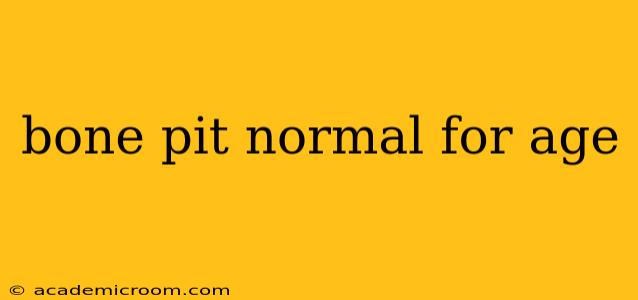As we age, our bodies undergo numerous changes, and our bones are no exception. While some changes are perfectly normal parts of the aging process, others might warrant a visit to a doctor. One question many people have is about the appearance of "bone pits," or what may appear to be small indentations or depressions in the bone. Let's explore what these might be and whether they're a typical part of aging.
It's crucial to understand that the term "bone pits" isn't a precise medical term. What someone perceives as a "bone pit" might actually be several different things, including:
- Normal bone variations: Bone structure varies significantly from person to person. Some individuals naturally have slightly uneven bone surfaces, with small indentations or irregularities that are perfectly harmless.
- Bone resorption: As we age, the process of bone resorption (the breakdown of old bone tissue) increases. This can sometimes result in visible changes to the bone's surface, potentially leading to what might appear as small pits or depressions. This is usually a gradual process and a normal part of aging. However, excessive bone resorption can indicate conditions like osteoporosis, which requires medical attention.
- Trabecular bone changes: Trabecular bone is the spongy, porous type of bone found inside larger bones. With age, the trabeculae (the thin, bony struts) can thin and become less dense, potentially leading to visible changes on the surface. This is a normal consequence of aging.
- Benign bone lesions: In some cases, small, benign bone lesions could be mistaken for "bone pits." These lesions are usually harmless but could be detected through imaging tests if necessary.
- Other conditions: In rare instances, "bone pits" might be a sign of a more serious underlying condition. This could include infections, tumors, or metabolic disorders affecting bone health.
Are Bone Pits a Sign of Osteoporosis?
One of the most common concerns related to bone changes with age is osteoporosis. While bone resorption is a normal part of aging, excessive bone loss can lead to osteoporosis. This condition weakens the bones, making them more prone to fractures. Osteoporosis doesn't always present with visible "bone pits," but it can lead to other noticeable symptoms like decreased height, back pain, and an increased risk of fractures.
What Causes Changes in Bone Structure With Age?
Several factors contribute to age-related bone changes:
- Hormonal changes: Decreased estrogen levels in women after menopause significantly contribute to bone loss.
- Nutritional deficiencies: A lack of calcium, vitamin D, and other essential nutrients can impact bone health.
- Lack of exercise: Weight-bearing exercise is crucial for maintaining bone density.
- Genetic factors: Family history of osteoporosis increases the risk.
When Should I See a Doctor About Bone Changes?
While some changes in bone structure are normal with aging, it's always best to consult a doctor if you notice:
- Sudden or significant changes in bone appearance.
- Pain or tenderness in the affected area.
- Unusual swelling or inflammation.
- Limited range of motion.
- Unexplained bone fractures.
- Significant decrease in height.
A doctor can properly diagnose the cause of any bone changes you're concerned about. They might recommend further investigations, such as X-rays, bone density scans (DEXA scans), or other imaging techniques to determine the underlying cause and the best course of action.
How Can I Maintain Healthy Bones as I Age?
Maintaining healthy bones throughout life is crucial for preventing age-related bone problems. Focus on:
- A balanced diet rich in calcium and vitamin D.
- Regular weight-bearing exercise.
- Avoiding smoking and excessive alcohol consumption.
- Getting regular medical checkups, especially after menopause.
- Discussing bone health concerns with your doctor.
By understanding the normal changes associated with aging and seeking professional guidance when necessary, you can maintain strong, healthy bones and improve your overall well-being. Remember, this information is for general knowledge and does not constitute medical advice. Always consult with a healthcare professional for any health concerns.
